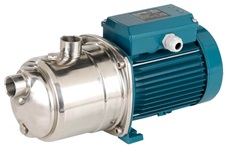CALPEDA
Calpeda MXP 20x horizontal multi-stage close coupled pumps 3x400V

from 350.03 €
Skip to content | Go to the main menu | Go to search
Don't have an account? Registration
The pump is a unit composed of a drive unit and its own pump, which imparts motion energy to water. In terms of construction, we distinguish the following types of pumps:
A - Centrifugal Pumps (most common):
B - Spindle Pumps - transport water by turning the stainless steel screw in the rubber stator. The advantage is the high displacement of up to 80m of water column. The shortage of these pumps is a limited flow to 60l/min and a higher possibility of damaging the hydraulic part of the pump when running dry (without water).
C - Vibrating pumps - instead of an electric motor, they have an electromagnet that attracts a steel anchor, stored in rubber, to the rhythm of the mains frequency, thus pushing water into the pipeline. The advantage is the displacement up to 40m, lack of sensitivity to the ingress of dirt, maximum flow rate of 25l/min and maximum operating time of 4 hours.